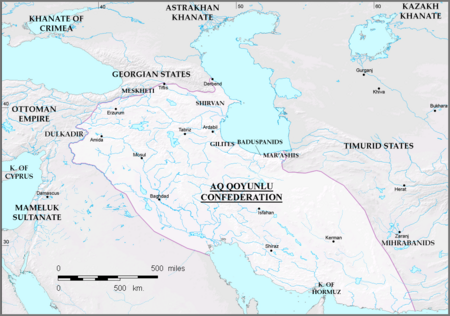Uzun Hasan facts for kids
Quick facts for kids Uzun Hasan |
|||||
|---|---|---|---|---|---|
| Padishah of Iran | |||||
| Sultan of the Aq Qoyunlu | |||||
| Reign | Autumn of 1452 – 6 January 1478 | ||||
| Predecessor | Jahangir | ||||
| Successor | Sultan Khalil | ||||
| Born | 1423 Diyarbakir |
||||
| Died | January 6, 1478 (aged 54–55) | ||||
| Spouse | Seljuk Shah Khatun Jan Khatun Tarjil Khatun Despina Khatun |
||||
| Issue | Ughurlu Muhammad Sultan-Khalil Yaqub Beg Maqsud Beg Yusuf Beg Masih Beg Zegnel Beg Alamshah Halima Khatun Two other daughters |
||||
|
|||||
| Dynasty | Aq Qoyunlu | ||||
| Father | Ali Beg | ||||
| Mother | Sara Khatun | ||||
| Religion | Sunni Islam | ||||
| Tughra |  |
||||
Uzun Hasan (born 1423, died January 6, 1478) was a powerful ruler of the Turkoman Aq Qoyunlu state. His name, Uzun, means "tall" in the Oghuz Turkic language. He ruled from 1452 to 1478. During his time, the Aq Qoyunlu empire grew very large. It included parts of what are now Iraq, Turkey, Azerbaijan, Iran, Transcaucasia, and Syria. Many people consider him the strongest ruler of the Aq Qoyunlu.
Contents
Uzun Hasan's Rule

Uzun Hasan's grandfather, Kara Yülük Osman, was a governor appointed by Timur. Timur was the founder of the Timurid Empire. Kara Yülük Osman governed important cities like Diyarbakır and Erzincan.
Expanding the Empire
Uzun Hasan fought against another ruler named Jahan Shah of the Qara Qoyunlu state. After twenty years of battles, Uzun Hasan finally defeated Jahan Shah in 1467. This important victory happened near Çapakçur in eastern Turkey.
After Jahan Shah's defeat, another ruler, Abu Sa'id Mirza, tried to take over the land. Uzun Hasan offered peace, but Abu Sa'id Mirza refused. Uzun Hasan then surprised and captured Abu Sa'id.
Relations with European Powers
In 1463, the city of Venice in Italy wanted to find allies. They were fighting a war against the powerful Ottoman Empire. Venice sent an ambassador named Lazzaro Querini to Uzun Hasan's capital, Tabriz. They hoped Uzun Hasan would attack the Ottomans. However, he did not agree to attack at that time.
Later, in 1471, another Venetian ambassador, Caterino Zeno, visited Uzun Hasan. Zeno had a special connection because his wife was related to Uzun Hasan's wife. Zeno managed to convince Uzun Hasan to attack the Ottomans. Uzun Hasan had some early success in these battles. But the European powers did not attack at the same time, which made it harder for him.
Uzun Hasan fought the Ottomans in several battles. He attacked places like Tokat in 1471. However, he was defeated by the Ottoman Sultan Mehmed II at the Battle of Otlukbeli in 1473.
After this, another Venetian ambassador, Giosafat Barbaro, arrived. He got along well with Uzun Hasan. But he could not convince the ruler to attack the Ottomans again.
Family Challenges
Around this time, Uzun Hasan's son, Ughurlu Muhammad, started a rebellion. He took control of the city of Shiraz.
Another Venetian ambassador, Ambrogio Contarini, visited Uzun Hasan's court. Contarini later wrote about his travels. He described Uzun Hasan as "tall and thin" with a friendly face. He also noted that Uzun Hasan's hands trembled.
Contarini also wrote about the size of Uzun Hasan's empire. He mentioned that Tabriz was Uzun Hasan's main home. He also said that Uzun Hasan had an army of about 50,000 horsemen.
Uzun Hasan died in 1478. After his death, his sons fought each other to become the next ruler.
Uzun Hasan's Family

Uzun Hasan had four wives and many children.
Wives
- Seljuk Shah Khatun
- Jan Khatun
- Tarjil Khatun
- Theodora Megale Komnene, also known as Despina Khatun. She was the daughter of Emperor John IV of Trebizond. They married in 1458.
Sons
Uzun Hasan had at least seven sons:
- Ughurlu Muhammad (died 1477): His son, Ahmad Beg, later became a ruler for a short time.
- Mirza Khalil Beg (died 1478): He became sultan after his father's death.
- Ya'qub Beg (died 1490): He became sultan after defeating his brother Khalil.
- Maqsud Beg (died 1478): He was executed by Khalil.
- Yusuf Beg
- Masih Beg
- Zegnel Beg
Daughters
Uzun Hasan had at least three daughters:
- Halima Alamshah Khatun (1460–1522): She married her cousin, Shaykh Haydar. Their son was Shah Ismail I, who later founded the Safavid Empire.
- Two other daughters with Despina Khatun.
Uzun Hasan's Legacy
Uzun Hasan was important because he tried to change the Aq Qoyunlu state. He wanted it to be more like a traditional Islamic kingdom, not just a group of tribes. As his empire grew, he hired experienced Iranian officials to help him govern. These officials helped blend the Turkic tribes with the older Persian and Islamic ways of ruling.
Uzun Hasan also supported Islamic groups and Sufi orders. He even arranged for his sister to marry Shaykh Junayd, a leader of the Safavid order. He also married one of his daughters to Junayd's son, Shaykh Haydar. These marriages were important for future history.
Uzun Hasan also ordered the Quran to be translated into the Turkic language.
He also started some important changes to the laws and how the government worked. He wanted to make his large state stronger and reduce the power of the military leaders. While we don't have all the details of his laws, some old writings mention "King Hasan's Laws." These laws aimed to make things fairer. For example, he tried to cut taxes by half. He also wanted lawbreakers to be punished strictly.
Even after the Ottoman Empire took over some of the Aq Qoyunlu lands, they kept Uzun Hasan's laws for a while. This shows how important and effective his reforms were.


